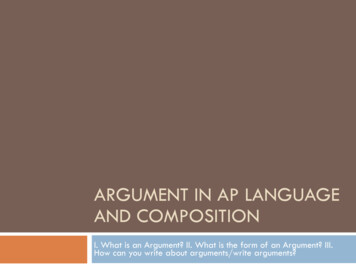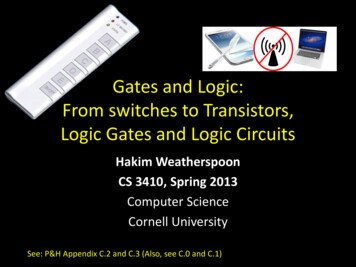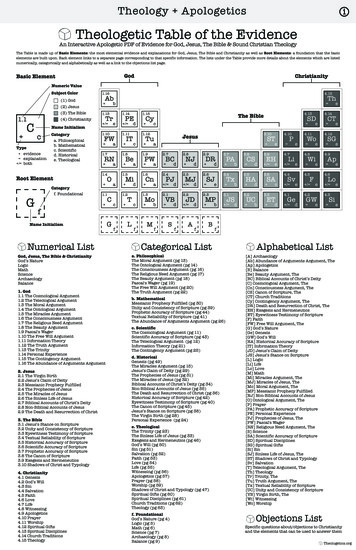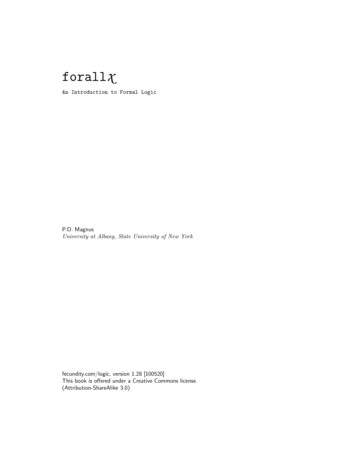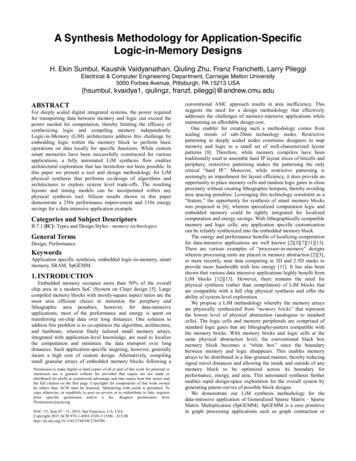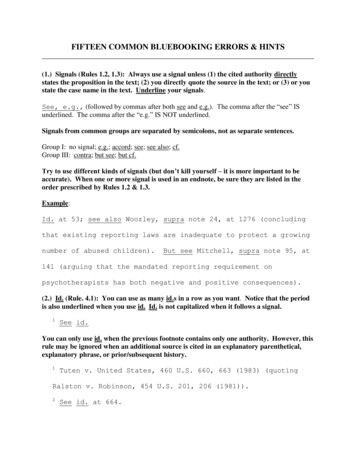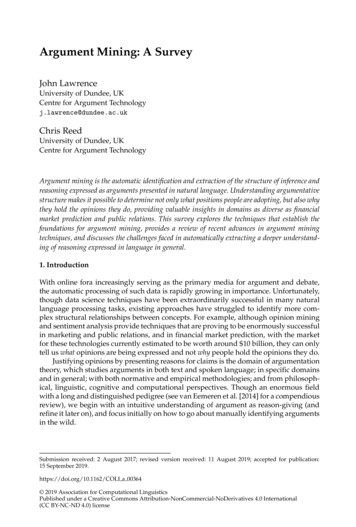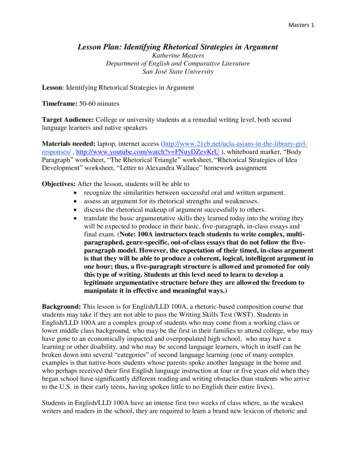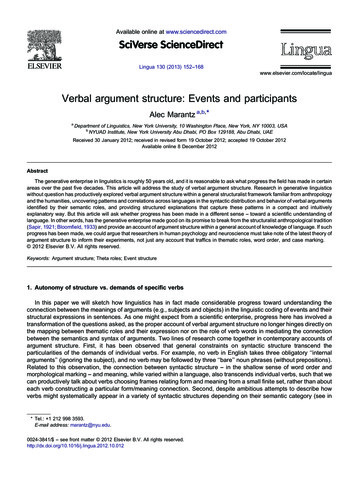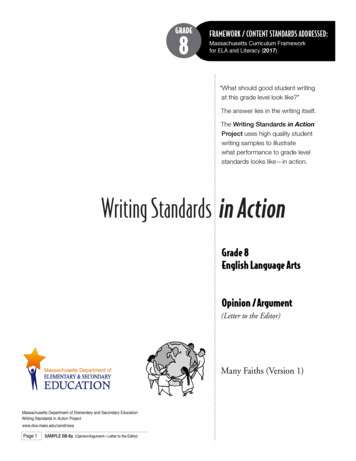
Transcription
Proposition logic and argumentCISC2100, Fall 2019X.Zhang1
Where are my glasses?I know the following statements are true.1. If I was reading the newspaper in the kitchen, then my glasses are onthe kitchen table.2. If my glasses are on the kitchen table, then I saw them at breakfast.3. I did not see my glasses at breakfast.4. I was reading the newspaper in the living room or I was reading thenewspaper in the kitchen.5. If I was reading the newspaper in the living room then my glasses areon the coffee table.More likely scenario for you: where are bugs in my CS1 program?you might find yourself reasoning through your code: if a 0 here, thenthis line is executed, which makes b 0, .2
Algebraic for logicRecall that you know1 10 10 1, 45 23 23 45, and in general, a b b a,2 * (3 10) 2*3 2*10, in general a(b c) ab ac . Similarly, definitions of formal logic were developed tocapture natural or intuitive logic used by people Benefits: allow us to see structures (forms) of arguments moreclearly avoid fallacy (or logic errors)3
Outline Review: (propositional) logic Logic Equivalence Arguments Rule of inferences Fallacy4
Statements: simple and compound A statement (proposition) is a statement that is true or false, but notboth. Compound statement can be formed from simple statement asfollows: Given statement p,q, “ p” (“not p”, “It is not the case that p”) is called negation of p. “p q” (“p and q”) is conjunction of p and q. “p q” (“p or q” ) is disjunction of p and q “p q” (p exclusive or q) “p q” (if p then q) is conditional “p q” (p if and only if q) is biconditional5
English to SymbolsWrite following sentences symbolically, lettingh “It is hot” and s “It is sunny.”a. It is not hot but it is sunny.b. It is neither hot nor sunny.6
Truth Table definition of negationNegation of a statement is a statement that exactlyexpresses the original statement to be false.summarized in a truth table:Truth Table for p7
Definition of conjunction (and)summarized in a truth table.Truth Table for p q8
Definition of Disjunction (or)Here is the truth table for disjunction:Truth Table for p q9
Exclusive OrConsider statement(p q) (p q).This means “p or q, and not both p and q”, i.e., exclusive or.This is often abbreviated as10
Evaluating the Truth of MoreGeneral Compound StatementsNow that truth values have been assigned to p, p q, andp q, consider the question of assigning truth values tomore complicated expressions such as p q,(p q) (p q), and (p q) r. Such expressions arecalled statement forms (or propositional forms).11
Conditional StatementsLet p and q be statements. A sentence of the form “If p thenq” is denoted symbolically by “p q”; p is called thehypothesis and q is called the conclusion, e.g.,12
Meaning of Conditional Statements Based on its everyday, intuitive meaning.Manager: “If you show up for work Monday morning,then you will get the job”When will you be able to say that the manager lies?Only if you show up on Monday morning, but you did notget the job.Truth Table for p q When “if” part (hypothesis) is false, the wholeconditional statement is true, regardless of whetherconclusion is true or false. In this case, we say the conditional statement isvacuously true or true by default.thus the statement is vacuously true if you do not showup for work Monday morning.13
A Conditional Statement with aFalse HypothesisConsider the statement:If 0 1 then 1 2.As strange as it may seem, since the hypothesis of thisstatement is false, the statement as a whole is true.14
Only If“p only if q” means that p can take place only if q takesplace also. i.e., if q does not take place, then p cannot take place. or, if p occurs, then q must also occur.15
Interpreting Only IfRewrite following statement in if-then forms:John will break the world’s record for the mile runonly if he runs the mile in under four minutes.16
If and only If (Biconditional)The biconditional has the following truth table:Truth Table for p q17
Necessary and Sufficient Conditions “r is a sufficient condition for s” means that the occurrenceof r is sufficient to guarantee the occurrence of s. “r is a necessary condition for s” means that if r does notoccur, then s cannot occur either. The occurrence of r isnecessary to obtain the occurrence of s.18
Necessary and Sufficient ConditionsConsider statementIf John is eligible to vote, then he is at least 18 years old.The truth of the condition “John is eligible to vote” issufficient to ensure the truth of the condition “John is at least18 years old.”In addition, the condition “John is at least 18 years old” isnecessary for the condition “John is eligible to vote” to betrue.If John were younger than 18, then he would not be eligibleto vote.19
Only If and the BiconditionalAccording to the separate definitions of if and only if, saying“p if, and only if, q” should mean the same as saying both “pif q” and “p only if q.”The following annotated truth table shows that this is thecase:Truth Table Showing that p q (p q) (q p)20
Exercise: If and Only IfRewrite the following statement as a conjunction of twothen statements:if-This computer program is correct if, and only if, it producescorrect answers for all possible sets of input data.21
Precedence of logical operatorsThe full hierarchy of operations for the five logical operatorsis:Practice:p q pp q r p r22
Outline Review: (propositional) logic Logic Equivalence Arguments Rule of inferences Fallacy23
Logical EquivalenceStatements(1) 6 is greater than 2(2) 2 is less than 6are saying same thing,because of definition of phrases greater than and lessthan.24
Logical EquivalenceStatements(1) Dogs bark and cats meowand(2) Cats meow and dogs barkalso say same thing (either both are true, or both be false) Not because of definition of the words. It has to do with logical form of the statements. Any two statements whose logical forms are related in sameway as (1) and (2) would mean the say thing. 25
Logical EquivalenceCompare truth tables for logic forms of two statements:1.statement variables p and q are substituted for componentstatements “Dogs bark” and “Cats meow,” respectively.2.truth table shows that for each combination of truth valuesfor p and q, p q is true when, and only when, q p is true.In such a case, statementforms are called logicallyequivalent, and we saythat (1) and (2) arelogically equivalentstatements.26
Logical Equivalence27
Testing Logical EquivalenceTesting Whether Two Statement Forms P and Q AreLogically Equivalent1. Construct a truth table with one column for P and anothercolumn for Q.2. Check each combination of truth values of the statementvariables to see whether the truth value of P is the sameas the truth value of Q.a. If in every row the truth value of P is the same as thetruth value of Q, then P and Q are logically equivalent.b. If in some row P has a different truth value from Q,then P and Q are not logically equivalent.28
Prove non-Logical Equivalence Use a truth table to find rows for whichtheir truth values differ, or Find concrete statements for each of thetwo forms, one of which is true and theother of which is false.29
Showing NonequivalenceStatement forms (p q)and p q30
Showing Nonequivalencecont’d (p q) and p qLet p be statement “0 1” andLet q be statement “1 0.”Thenwhich is true.which is false.31
De Morgan’s lawsnamed after Augustus De Morgan, who was first to statethem in formal mathematical terms.32
Applying De Morgan’s LawsWrite negations for following statements:John is 6 feet tall and he weighs at least 200 pounds.The bus was late or Tom’s watch was slow.33
Outline Review: (propositional) logic Logic Equivalence Arguments Rule of inferences Fallacy34
Tautologies and Contradictionsthe truth of a tautological statement (and the falsity of acontradictory statement) are due to logical structure of thestatements themselves, and are independent of themeanings of the statements.35
Logical Equivalence InvolvingTautologies and ContradictionsIf t is a tautology and c is a contradiction, show thatp t p and p c c.Solution:36
Summary of Logical Equivalences37
Simplifying Statement FormsUse Theorem 2.1.1 to verify the logical equivalence38
Exercise: Truth Table for p q pConstruct a truth table for the statement form p q p.Solution:By order of operations:p q pis equivalent to(p ( q)) ( p)39
Exercise: Division into CasesShow that statement formsp q rand(p r ) (q r).are logically equivalent.(Hint: draw truth table, and explain).40
Solutioncont’d41
p q and p qRewrite the following statement in if-then form.Either you get to work on time or you are fired.42
Negate Conditional StatementBy definition, p q is false if, and only if,its hypothesis, p, is true and its conclusion, q, is false. Itfollows thatsymbolically,43
Negate If-Then StatementsIf my car is in the repair shop, then I cannot get to class.Negation:If Sara lives in Athens, then she lives in Greece.Negation:44
Contrapositive of a ConditionalStatementThe fact is that45
Writing the ContrapositiveIf Howard can swim across the lake, then Howard can swimto the island.Contrapositive:If today is Easter, then tomorrow is Monday.Contrapositive:46
The Converse and Inverse of aConditional Statement47
Writing the Converse and theInverseIf Howard can swim across the lake, then Howard can swim tothe island.Converse:Inverse:If today is Easter, then tomorrow is Monday.Converse:Inverse:48
Logically equivalent or not?conditional statementp qinverse: p qconverse:q pcontrapositive: q p49
Outline Review: (propositional) logic Logic Equivalence Arguments Rule of inferences Fallacy50
Valid and Invalid Arguments In mathematics and logic an argument is not a dispute. Argument: is a sequence of statements ending in aconclusion.If Socrates is a man, then Socrates is mortal.Socrates is a man.Socrates is mortal. In logic, we focus on whether an argument is valid or not— i.e., whether the conclusion follows necessarily from thepreceding statements.51
Are they valid arguments? Consider the following three argumentsIf Socrates is a man, then Socrates is mortal.Socrates is a man.Socrates is mortal.If Scoopy is a man, then Scoopy is mortal.Scoopy is a mortal.Scoopy is a man.If you see Tom, then you see Jerry.You see Tom.You see Jerry. Observation: arguments (1) and (3) follows same logic!52
Valid and Invalid ArgumentsFor example, the argumentIf Socrates is a man, then Socrates is mortal.Socrates is a man.Socrates is mortal.has the abstract formIf p then qpqAn argument is called valid if, and only if, whenever all thepremises are true (are satisfied), the conclusion is also true.53
Valid and Invalid ArgumentsWhen an argument is valid and its premises are true, thetruth of the conclusion is said to be inferred or deduced fromthe truth of the premises.54
Testing validity of argument form1. Identify premises and conclusion of argument form.2. Construct a truth table showing truth values of allpremises and conclusion, under all possible truth valuesfor variables.3. A row of the truth table in which all the premises are trueis called a critical row.If there is a critical row in which conclusion is false, then it ispossible for an argument of the given form to have true premisesand a false conclusion, and so the argument form is invalid.oIf conclusion in every critical row is true, then argument form isvalid.o55
Example 1 – Determining Validity orcont’dInvalidityp q rq p rp rSolution:there is one situation (row 4) where the premises are trueand the conclusion is false.56
Modus Ponens An argument form consisting of two premises and aconclusion is called a syllogism. The first and second premises are called the majorpremise and minor premise, respectively. Most famous form of syllogism in logic is called modusponens with following form:If p then q.pq57
Modus PonensIt is instructive to prove that modus ponens is a valid form ofargument, to confirm agreement between formal definition ofvalidity and intuitive concept.To do so, we construct a truth table for premises andconclusion.58
Modus TollensConsideranother valid argument form called modus tollens.with following form:If p then q. q p59
Exercise:Use modus ponens or modus tollens to fill in the blanks ofthe following arguments so that they become validinferences.a. If there are more pigeons than there are pigeonholes,then at least two pigeons roost in the same hole.There are more pigeons than there are pigeonholes. b. If 870,232 is divisible by 6, then it is divisible by 3.870,232 is not divisible by 3. 60
SummaryofRulesofInferenceValid Argument Forms Commonly used valid argument forms (also called rule ofinference)61
Rule of Generalizationa. p p q b. q p qUsed for making generalizations. in a), if p is true, then, more generally, “p or q” is true for any otherstatement q. e.g. to count upperclassmen in a class. You find out Anton is junior, andreason:Anton is a junior. (more generally) Anton is a junior or Anton is a senior.Knowing that upperclassman means junior or senior, Anton is added intoyour list.62
Rule of Specializationfollowing argument forms are valid:a. p qb. p qpq Used for specializing, discard extra info, to concentrate onparticular property of interest. e.g., You are looking for someone knows graph algorithms. You discover that Ana knows both numerical analysis and graphalgorithms, and reason:Ana knows numerical analysis and Ana knows graphalgorithms. (in particular) Ana knows graph algorithms.63
Rule of Eliminationa.p q qpb.p q pqIdea: You have only two possibilities, and you can rule oneout, then the other must be the case.64
Elimination examplecont’dExample: suppose you know that for a particular number x,If you also know that x is not negative, then x 2, soBy elimination, you can then conclude thatx-3 065
Rule of Transitivityp qq r p r Many arguments contain chains of if-then statements. From the fact that one statement implies a second andthe second implies a third, you can conclude that thefirst statement implies the third.66
Example – Transitivitycont’dHere is an example:If 18,486 is divisible by 18, then 18,486 is divisible by 9.If 18,486 is divisible by 9, then the sum of the digits of18,486 is divisible by 9. If 18,486 is divisible by 18, then the sum of the digits of18,486 is divisible by 9.67
Proof by Division into Casesfollowing argument form is valid:p qp rq rr It often happens that you know one thing or another is true.If you can show that in either case a certain conclusionfollows, then this conclusion must also be true.68
Example: Proof by Division intoCasescont’d For instance, suppose you know that x is a particularnonzero real number. The trichotomy property of the realnumbers says that any number is positive, negative, orzero. Thus (by elimination) you know that x is positive or xis negative.You can deduce that x2 0 by arguing as follows:x is positive or x is negative.If x is positive, then x2 0.If x is negative, then x2 0. x2 0.69
Contradictions and Valid Arguments p c, where c is a contradiction p contradiction rule is logical heart of method of proof bycontradiction. A slight variation also provides the basis for solvingmany logical puzzles by eliminating contradictoryanswers: If an assumption leads to a contradiction, thenthat assumption must be false.70
Where are my glasses?I know the following statements are true.a. If I was reading the newspaper in the kitchen, then my glasses are onthe kitchen table.b. If my glasses are on the kitchen table, then I saw them at breakfast.c. I did not see my glasses at breakfast.d. I was reading the newspaper in the living room or I was reading thenewspaper in the kitchen.e. If I was reading the newspaper in the living room then my glasses areon the coffee table.71
Outline Review: (propositional) logic Logic Equivalence Arguments Rule of inferences Fallacy72
Fallacies A fallacy is an error in reasoning that results in an invalidargument. Three common fallacies are using ambiguous premises, and treating them as ifthey were unambiguous, circular reasoning (assuming what is to be provedwithout having derived it from the premises), jumping to a conclusion (without adequate grounds). two other fallacies (seemingly valid argument) converse error inverse error73
Fallacies74
Converse ErrorShow that following argument is invalid:If Zeke is a cheater, then Zeke sits in the back row.Zeke sits in the back row. Zeke is a cheater. The fallacy underlying this argument form is called converseerror, because conclusion of the argument would follow from thepremises if premise p q were replaced by its converse. Such a replacement is not allowed, because a conditionalstatement is not logically equivalent to its converse. also known as fallacy of affirming the consequent.75
Inverse ErrorConsider following argument:If interest rates are going up, then stock market prices will godown.Interest rates are not going up. Stock market prices will not go down.the form of above argument is:p q p q Such fallacy is called inverse error: as it confuse premise p qwith its inverse. But p q is not equivalent to its inverse also known as the fallacy of denying the antecedent.76
Argument being valid vs Conclusionbeing trueIs following argument valid? Is the conclusion true?If John Lennon was a rock star, then John Lennonhad red hair.John Lennon was a rock star. John Lennon had red hair.Is following argument valid? Is the conclusion true?If New York is a big city, then New York has tallbuildings.New York has tall buildings.77 New York is a big city.
Sound ArgumentArgument is valid does not mean the conclusion is true.as some premises might be false.If John Lennon was a rock star, then John Lennonhad red hair.John Lennon was a rock star.Valid not unsound! John Lennon had red hair.An argument is called sound if and only if, it is valid and allits premises are true; otherwise, an argument is calledunsound.78
SummaryofRulesofInferenceValid Argument Forms79
In mathematics and logic an argument is not a dispute. Argument: is a sequence of statements ending in a conclusion. If Socrates is a man, then Socrates is mortal. Socrates is a man. Socrates is mortal. In logic, we focus on whether an argument is valid or not — i.e., whether

